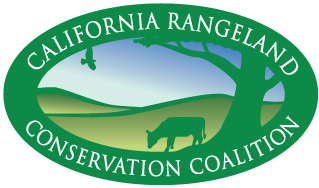Facts on Environmental Benefits of Ranching in California by category listed below.
- General Rangeland Facts
- Birds
- Bees
- Bugs, Amphibians & More
- Butterflies
- Wildlife
- Plants, Flowers & Trees
- 34.1 million acres or 34 percent of California is actually grazed and most of this is on private lands. (California Department of Forestry and Fire Protection. 2010. California’s Forests and Rangelands: 2010 Assessment)
- Almost all of our surface water, including most of the state’s drinking water, crosses the state’s millions of acres of rangeland. (University of California)
- Rangelands provide flood protection and ground water recharge. Research shows that approximately 6 to 10 inches of precipitation are required to initiate stream flow on a watershed. Once the water-holding capacity of the soil was filled, additional precipitation generated stream flow. (Dalghren et al, 2001)
- U.S. grazing lands, including managed pasturelands, have the potential to remove an additional 198 million tons of carbon dioxide (CO2) from the atmosphere per year for 30 years (Follett et al. 2001). This would offset 3.3 percent of U.S. CO2 emissions from fossil fuels (EIA 2008) and help protect grazing land soil quality for the future.
- Heavy grazing favors California ground squirrels, a primary prey for golden eagles. (UC, ANR Publication 21626, 2006)
- Pocket gophers have higher populations in grazed meadows, this may benefit Great Gray Owls because pocket gophers are an alternate source of prey. (Powers, et al 2011)
- Recreation can be enhanced by cattle grazing (flowers and opening up dense vegetated areas) and are compatible uses on the landscape (e.g. East Bay Regional Park District).
- Grazing is an important disturbance in vernal pool grasslands. Grazed vernal pools have higher native plant diversity, and they hold water longer than ungrazed pools. This favors species with long aquatic life cycles like the California tiger salamander and plants such as goldfields and Downingia. (Marty 2005)
- California’s annual grasslands have soil Carbon storage capacity and offer an important resource for mitigation of greenhouse gas emissions and climate change. (Silver, et al. 2010)
- Grazing of perennial grasslands has helped control the spread of some invasive weed species in several areas (Stromberg et al. 2007).
- Livestock grazing can decrease levels of nitrate pollution in wetland waters. (Allen-Diaz et al. 2004)
- Cattle grazing can be an important and effective approach to manage coastal grasslands. (Cushman 2009)
- Prescribed grazing, using cattle and/or sheep, is a tool that can be used to manage vegetation to meet wildlife habitat objectives. (USFWS Bitter Creek NWR Draft Prescribed Grazing Plan 2012)
- 98 percent of farms and ranches in the United States are family owned and operated. (USDA 2004)
 BIRDS
BIRDS
- Black rails in the Sierra Foothills find habitat maintained by irrigation water used for cattle ranching. The greatest long-term threat to the bird is the replacement of ranching with residential land use. (Richmond, et al. 2010)
- 97.9% of observations of foraging geese occurred on pastures previously or concurrently grazed by cattle (Bogiatto, et al. 2009)Aleutian Cackling Geese are attracted to irrigated pastures and wet landscapes that are grazed. Livestock grazing of these pastures reduces dead materials and increasing the nutritive qualities of the forage for geese, creating a high in protein food source preferred by the bird. (Aleutian Goose Agricultural Depredation Management plan 2006).Large expanses of cattle-grazed vernal pool rangelands provide an abundance of high quality food resources, resting places and shelter for migratory waterfowl and shorebirds at a critical time of their annual life-cycle ( Silveira 1998, Bogiatto and Karnegis 2006, Bogiatto et al. 2009).California’s Central Valley supports the continent’s highest winter abundance and diversity of open-country hawks, and many of those species are dependent on grasslands (Root 1988, Pandolfino 2006). Federal Bird Species of Conservation Concern which use California grassland habitats extensively include Swainson’s Hawk, Golden Eagle, Long-billed Curlew, Short-eared Owl, and Horned Lark. (U.S. Fish & Wildlife Service 2008)
- Ferruginous Hawk, Rough-legged Hawk, and Prairie Falcon, show a positive association with grassland and no other Central Valley habitat type. These same species prefer grazed over ungrazed grassland. (Pandolfino et al. 2011).
- California bird species of special concern which use grazed grassland habitats extensively include Mountain Plover, Loggerhead Shrike, Grasshopper Sparrow, and Tricolored Blackbird. (Shuford and Gardali 2008)
- Burrowing Owl populations require maintenance of lands and disturbances to remove vegetation. The most desired habitat results for the species comes from grazing.(2007 Proceedings of the California Burrowing Owl Symposium November 2003)
- Livestock grazing in coastal pastures can be used to provide a mosaic of vegetation heights, which would yield greater waterbird diversity as well as higher densities of some species. (Colwell and Dodd, 1995)
- Grazing can provide benefits to the California Condors because grazing reduces cover of non-native grasses and opens habitat for foraging, and stillborn calves and dead cattle provide carcass feeding opportunities. (Tehachapi Uplands Multiple Species Habitat Conservation Plan – Draft, 2012)
 BEES
BEES
- A study of native California bees shows that both the amount and the stability of pollination services increased with more available habitat which is largely provided on rangelands (Kremen et al., 2004).
- Much of the natural vegetation promoting the ecosystem service of pollination on farmlands is rangeland. This is important for pollinator-dependent species, such as almond, melon, blueberry, and apple. Rangeland habits such as grasslands, meadows, savannah, and shrublands, predominantly managed with livestock grazing, support diverse bee communities due to the wide variety of nesting habitats they supply. (Chaplin-Kramer, et al., 2011)
- Grazing, especially by cattle, can play a key positive role in maintaining the abundance and species richness of preferred Bumble Bee forage (Carvell 2001, p. 44). (USFWS petition to list Franklin’s bumble bee)
 BUGS, AMPHIBIANS & MORE
BUGS, AMPHIBIANS & MORE
- Grazing is the most common form of habitat management and appears to be historically correlated with Ohlone Tiger Beetle occurrences. (USFWS 2009)
- Research has demonstrated that the abundance of Western Fence Lizards and Western Skinks is significantly greater in grazed grasslands. (David Riensche 2005).
- Managed livestock grazing can benefit the Alameda Whipsnake by controlling non-native invasive plant species that negatively impact the species habitat. (USFWS 2011)
- The San Francisco garter snake is supported by grazing that reduces brush canopy and rancher stewardship that manages stock ponds. (USFWS 2006)
- Managed livestock grazing at low to moderate levels has a neutral or beneficial effect on California Red-Legged Frog habitat. (USFWS 2006).
- It is likely that California Tiger Salamanders would have been vacant from many areas if stock ponds, used by cattle as a drinking source, had not been built and maintained by ranchers for livestock production. (USFWS 2003/ 2004)
- Annual grazing studies have demonstrated the benefits of livestock grazing in reducing exotic grasses and increasing the federally endangered Blunt-Nosed Leopard Lizard numbers. (USFWS 2010)
 BUTTERFLIES
BUTTERFLIES
- It has been demonstrated that managed grazing can improve habitat for threatened and endangered species such as the Bay Checkerspot Butterfly, considered an umbrella species for grassland ecosystems (Murphy and Weiss, 1988).
- Managed grazing can increase the density of native plants that support San Bruno Elfin Butterfly and Mission Blue Butterfly populations. (USFWS 2010)
- Cattle grazing can benefit Smith’s Blue Butterfly. (Cushman, 2009)
 WILDLIFE
WILDLIFE
- Grazing by cattle has been identified as the most reasonable and economic strategy for managing San Joaquin Kit Fox habitat in California. (Constable et al. 2009)
- Population increases for Giant Kangaroo Rats and Short-Nosed Kangaroo Rats will be faster on grassed grasslands. (Germano, Rathburn and Saslaw 2011)
- Grazing has been found to benefit or have a neutral effect on San Joaquin Antelope Squirrels, Western Whiptail Lizards; Side-Blotched Lizards; San Joaquin Pocket Mice; and Heermann’s Kangaroo Rats. (Germano, Rathburn and Saslaw 2011)
- Livestock grazing has been identified as a potential habitat management tool to reduce thatch, creating habitat preferred by the Tipton Fangaroo Rat. (USFWS 2010)
- The Stephens’ kangaroo rat benefits from the livestock grazing artificial disturbance the opens up vegetation. (Brehme, et al 2005)
 PLANTS, FLOWERS & TREES
PLANTS, FLOWERS & TREES
- When not controlled by grazing or other management, a consistent pattern of heavy growth of non-native grasses can ‘smother’ native plants, resulting in the subsequent crowding out, outcompeting, or overshadowing of native annuals, including Calistoga Popcorn Flower and Napa Bluegrass. (USFWS 2010)
- The Santa Cruz Tarplant populations decrease because of removal of livestock grazing. (Hayes, 1998)
- Exclusion of livestock grazing on rangelands with Large-Flowered Fiddleneck can lead to the destruction of natural plant populations. (USFWS 2009)
- Grazing promotes plant diversity (e.g. cattails, sedges, rushes and perennial grasses) in spring fed wetlands. (Allen-Diaz, et al. 2004)
- Grazing can enhance habitat for Palmate-Bracted Bird’s-Beak through the removal of invasive non-native plants. Without grazing, weed cover increases significantly and the species is shown to decline over time. (USFWS 2009)
- The rare Sonoma Spine Flower have a larger presence where there is livestock grazing. (Liam and Sherman 1992)
- The Sonoma spineflower depends on the disturbance of cattle grazing, without grazing, non-native plants can outcompete the species. (Michelle Coppoletta and Barbara Moritsch 2011)
- Managed grazing and seedling shelters, installed by ranchers, enhance oak regeneration on rangelands (McCreary and George, 2005)
Permission is granted to use information derived from this list with credit given to the California Rangeland Conservation Coalition. For more information or questions regarding the information on this list, please contact Karen Sweet, ksweet@cattlemen.net.
